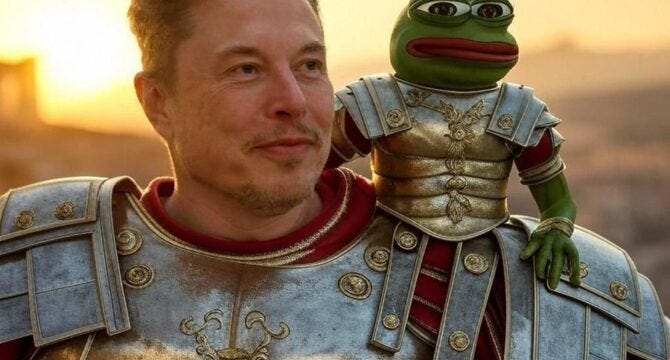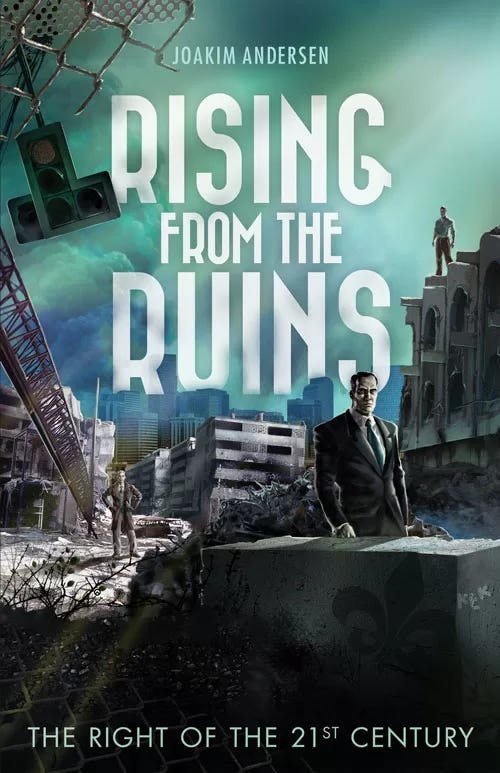Metapolitical Offensive 2025
by Joakim Andersen
Joakim Andersen describes the ongoing effort spearheaded by Trump and Elon Musk to dismantle left-liberal institutions and networks, reshaping the cultural power dynamic and offering breathing room for the advance of right-wing and populist forces.
Metapolitics is not only about ideas but equally about institutions. Over decades, left‑liberal actors have built networks and institutions around the state which bourgeois governments and Republican presidents usually have neither the will, the capacity, nor the courage to dismantle.
The boundaries between state and non‑state have been eroded; Curtis Yarvin has spoken in this context of “the Cathedral,” and I have referred to the “expanded state.” For example, it is obvious that actors financed by press subsidies cannot be considered independent of the state.
The intimate — and for that matter complex — relations between the modern state and the modern left cannot be understood without the modern academy of the sphere that both holds the monopoly on producing state employees and is the core of the modern left’s ideological development. Rather than the “proletariat,” it is certain intellectual, managerial, and/or academic strata that form the modern left’s revolutionary subject; at the same time they are to be seen as the ideological avantgarde of the modern state (with the small caveat that sometimes they are what Marx would have called lumpen strata, though more “lumpen intellectuals” than ragged proletarians).
This has long been the case, but now as it is being noticed, it is no longer entirely true. Trump 2.0 has to an unexpectedly high degree gone after institutions, driven by friend–enemy distinctions and the realization that some actors are enemies rather than rivals. We have seen this in the attacks on universities with anti‑white and anti‑Jewish policies. More recently, the Trump administration, with willing assistance from Elon Musk, tackled a number of central parts of the left‑liberal network.
The murder of Charlie Kirk led to the classification of American Antifa as a terrorist entity — an interesting member of the left‑liberal network because of its Janus nature: formal and informal, legal and illegal, and one of few actors within the managerial network that unites aspects of what Althusser called ISA and RSA (Ideological State Apparatus and Repressive State Apparatus). The latter is normally an area that attracts the post‑bourgeois proletariat more than managerial strata (compare Guillaume Faye’s arguments about the increasing radicalization of police and military and their tendencies to sympathize more with native populists than with their employers). At the same time, a precondition for this competitor for the monopoly of violence is strong support from other parts of the left‑liberal network, including media and the judiciary. In conflicts with the police or groups like the Proud Boys, this support is activated.
Connected to this are the relationships between groups like Antifa on one hand and organizations such as ADL (Anti‑Defamation League), SPLC (Southern Poverty Law Center) on the other — seemingly respectable mappers of “extremism” who themselves in many cases hold more or less “extreme” opinions and agendas (we leave aside for the moment the psychological mechanisms behind why leftist radicals much more often than bourgeois actors want to map “extremism”). Elon Musk and others have recently noted that ADL and SPLC hold a worldview that largely overlaps with that of the far left, for instance in labeling the murdered Kirk’s movement Turning Point USA an extremist hate group. The FBI has therefore broken its cooperation with both ADL and SPLC — “this FBI won’t partner with political fronts masquerading as watchdogs,” to quote FBI Director Patel. ADL has shuttered much of its archives.
Metapolitically, this is promising: it is untenable for a sitting government to delegate the task of defining and mapping “extremism” to groups that themselves hold a clear political agenda directed at that very government.
If one were not already open to Carlylean historiographical theory and its focus on “Great Men,” Elon Musk might serve as an argument for it. He forced the British establishment to confront the “British grooming gangs,” with sweeping consequences for British politics, and he has strongly contributed to the setbacks of the ADL and SPLC. Musk has highlighted that Google frequently links to SPLC; for example, their article on Stephen Miller appears high when one searches the Trump advisor’s name. There one reads that “Stephen Miller is credited with shaping the racist and draconian immigration policies of President Trump.” Other search results characterize Miller as an extremist and adherent of “white power.” The same is true on Wikipedia: there we read that “his politics have been described as far‑right, anti‑immigration, and white nationalist.”
We sense here the outlines of an ideological‑political infrastructure, in which the SPLC, Google, and Wikipedia construct a consensus across various issues. Wikipedia’s political leanings are probably well known: if you want to know which people you should dislike, you only need to look under “Controversies” on their Wikipedia pages. But even Wikipedia has now come under the metapolitical fire: the ousted founder Larry Sanger has published nine theses with reform proposals and been interviewed by Tucker Carlson. Also highly relevant but underreported is that Trump has disbanded the Community Relations Service, a somewhat obscure organization that, among other things, staged speeches in which relatives of white victims of interracial murders publicly distanced themselves from racism and so on.
All in all, it is an entire infrastructure that is being challenged and dismantled. The murder of Kirk was a contributing factor, but the Trump Administration had already begun the campaign against universities earlier. More concretely, it is the woke movement’s “material base” that has been attacked — this is not surprising, given that since October 7, Trump’s MAGA base and high‑right allies have a common enemy.
Which infrastructure ultimately takes its place remains to be seen; in the short term, however, the whole dynamic offers good opportunities for the genuine right and populism in the broader sense to advance their positions.
(Translated from the original Swedish article)





Spero che il mondo MAGA e Elon Musk possano trovare la forza per soverchiare la cultura Woke e tutte le aberrazioni della sinistra . Sarà difficile perché i gangli del partito democratico sono potenti e sovvenzionano tutti gli estremisti antifa e altre correnti terroristiche pro rivoluzioni colorate. Ma credo che con un impegno costante si possa sconfiggere le forze del male, e soprattutto l'America è in prima linea su questa battaglia, mentre l'Europa è ancora invischiata sulle aberrazioni della sinistra.